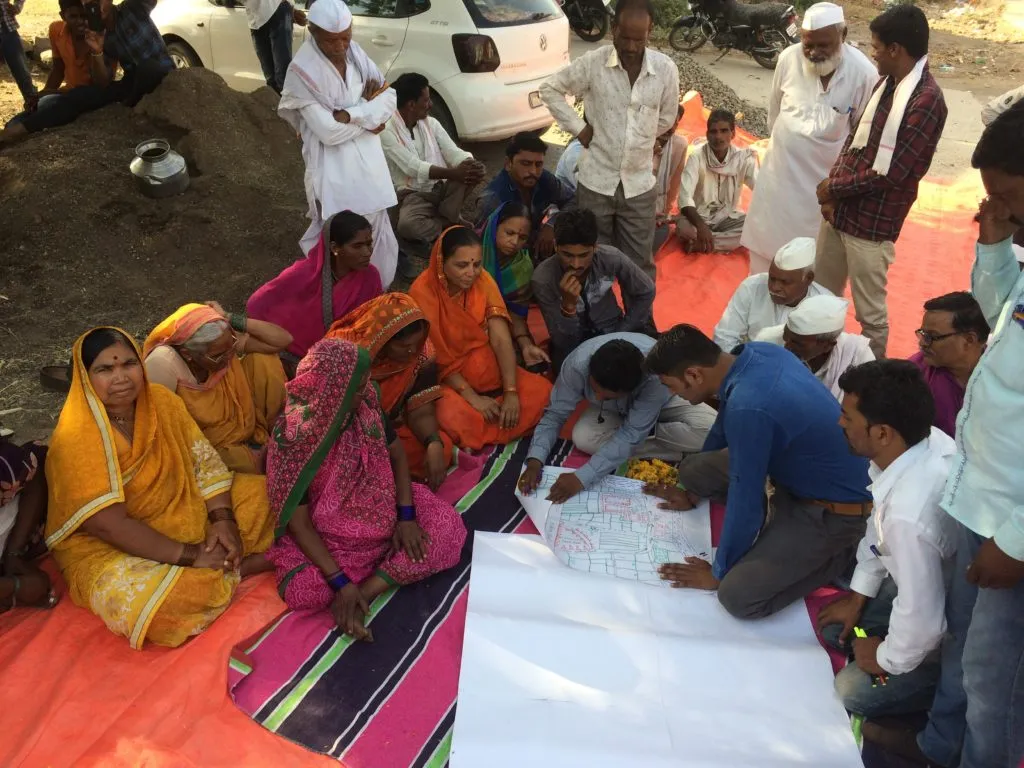
How to make biodiversity management simple for smallholder cotton farmers around the world
Last year we collaborated with BCI to develop a simple risk-based High Conservation Value procedure for smallholder cotton farmers
By working closely with the BCI Secretariat and drawing on existing HCV Network resources, we were able to develop a tailor-made solution for rapid biodiversity assessment, testing it out in the complex context of Indian cotton production.
The recently published IPBES Global Assessment highlights the contribution of the agriculture sector in causing severe biodiversity losses. For good reason there is a lot of attention on producer companies to do a better job at protecting biodiversity. Adopting the High Conservation Value Approach is one way to do this. But can we really expect the same from smallholder farmers? Just like any other farmer, smallholder farmers will make biodiversity-friendly decisions. For sustainability standards that set criteria to protect or restore biodiversity, the challenge is to have tools that work both for farmers and with their implementation and assurance systems. We have been working with Better Cotton Initiative (BCI) to develop these tools, specifically with smallholder farmers in mind for their recently updated Better Cotton Standard.
The vast majority of BCI cotton producers are smallholder farmers. India alone has >400,000 licensed BCI Farmers, each cultivating cotton on small plots of land of just a few hectares. Last year we collaborated with BCI to develop a simple risk-based High Conservation Value procedure. In the BCI context the HCV approach is applied when a farm plans to expand their cotton crop. But BCI still needed a tool to implement biodiversity management criteria for existing, non-expanding farms.
By working closely with the BCI Secretariat and drawing on existing HCV Network resources, we were able to develop a tailor-made solution for rapid biodiversity assessment, testing it out in the complex context of Indian cotton production. This started to produce demonstrable improvements in farming practices just as training is starting to get rolled out. We are thrilled by the positive response from the BCI Implementing Partners we met in India, to the biodiversity management tools. We are even more thrilled to contemplate what the cumulative benefits to biodiversity might be, resulting from changes made by individual farmers and farming communities, multiplied across a massive scale.
Developingthe biodiversity management tool
The starting point to develop a tool for BCI was our existing Forest Integrity Assessment Tool (FIA). FIA is a simple forest monitoring tool that uses biodiversity indicators of forest integrity to assess forest condition and set restoration targets. It can be used by local communities for self-assessment and forest monitoring without extensive training, and as an approach was therefore ideally suited to BCI’s smallholder context. We took two basic FIA principles – biodiversity indicators and focal species – and adapted them to the agricultural context of cotton production. The result was a simple global procedure that guides farmers and farming communities to identify and map biological resources, set targets to improve biodiversity, and restore degraded habitats. Another FIA principle is local adaptation of the indicators, which also was incorporated into the BCI procedure. A BCI national adaptation process refines the tools, also providing the flexibility to link with existing biodiversity initiatives.
Cascadetraining
Once developed, earlier this year we began training on the tools in India as part of BCI’s cascade training model. This started by training the 40 BCI Implementing Partners. The intention then is for partners to cascade their learning and the tools to production managers in their regions, which in turn is transferred to field facilitators and the farmers themselves. A field test of the tools and cascade training model was organised in the Jalna District, where WWF is the Implementing Partner. The production manager trained field facilitators, and we then visited one village and farmer to test the tools. The participating farmer agreed on some simple biodiversity-positive measures he would try the following growing season. This was a positive start, considering that one production manager represents >4000 farmers who could also be making these types of biodiversity-positive decisions. Then consider that >400,000 farmers in India alone meet BCI’s Standards, and that BCI represents around 20% of global cotton production. All of this must now meet BCI’s stricter requirements on biodiversity management, with the help of the tools developed by us.
For more information contact olivia@hcvnetwork.org
Related Posts
The Importance of Considering Land Use Planning and HCV Assessments for Disaster Mitigation
Every decision today shapes the fate of tomorrow's commit to protecting HCVs, and together we build a resilient future we all need and desire.
Read MoreDedicated webpage to more easily access resources on the Forest Integrity Assessment tool
Read More2024 Annual Report Highlights
We launched a bold new strategy and an innovative collaborative governance model. We helped shape the evolution of global standards and sustainability frameworks. Read our 2024 Annual Report to learn more.
Read MoreOur Partnerships
Alongside many global initiatives, our work with partners promotes practices that help meet the global Sustainable Development Goalsand build a greener, fairer, better world by 2030.


Femexpalma
In April 2022, FEMEXPALMA and the HCV Network signed a 5-year cooperation agreement to promote sustainable production of palm oil in Mexico. FEMEXPALMA is a Mexican independent entity that represents palm production at the national level and promotes the increase of productivity in a sustainable way.
With global markets becoming stricter, for Mexican producers to be able to export to key markets such as the European Union, they must meet strict requirements such as certification by the Roundtable on Sustainable Palm Oil (RSPO). To be certified by RSPO, the HCV Approach must be applied prior to the establishment of any new oil palm plantations. With this cooperation agreement, the HCV Network will support FEMEXPALMA’s members and allies to design better strategies to identify, manage and monitor High Conservation Values and support smallholders to achieve RSPO certification and implement good agricultural practices.


High Carbon Stock Approach
The High Carbon Stock Approach (HCSA) is an integrated conservation land use planning tool to distinguish forest areas in the humid tropics for conservation, while ensuring local peoples’ rights and livelihoods are respected.
In September 2020, HCV Network and the HCSA Steering Group signed a five-year Memorandum of Understanding (MoU) to strengthen their collaboration to conserve forests and uphold community rights in tropical forests. The HCS and HCV Approaches are cornerstones of corporate no deforestation and conservation commitments, and increasingly for actors working at different scales. The collaboration aims to further support effective implementation of these commitments through increased uptake of the HCV and HCS tools.
Through this MoU, HCSA and HCVRN are pursuing two main strategic goals:
- Strive to promote the application of the two approaches in tropical moist forest landscapes and explore further opportunities for collaboration.
- Ensure that, where the two approaches are applied together, this happens in a coordinated, robust, credible, and efficient manner, so that HCS forests and HCVs are conserved, and local peoples’ rights are respected.


World Benchmarking Alliance
From May 2022, the HCV Network is an ally at the World Benchmarking Alliance (WBA). WBA is building a diverse and inclusive movement of global actors committed to using benchmarks to incentivise, measure, and monitor corporate performance on the SDGs, and will assess and rank the performance of 2,000 of the world’s most influential companies against seven systems of transformation by 2023.
The scope of WBA’s circular transformation was expanded to cover nature and biodiversity as recognition of the need for greater understanding, transparency and accountability of business impact on our environment. The WBA Nature Benchmark was launched in April 2022, which will be used to rank keystone companies on their efforts to protect our environment and its biodiversity. As HCV Areas are recognised as key areas important for biodiversity, companies that publicly disclose their actions to identify and protect HCVs will contribute to the assessment of their performance against the benchmark.


Taskforce on Nature-related Financial Disclosures - TNFD
The Taskforce on Nature-related Financial Disclosures (TNFD) is a global, market-led initiative, established with the mission to develop and deliver a risk management and disclosure framework for organizations to report and act on evolving nature-related risks, with the aim of supporting a shift in global financial flows away from nature-negative outcomes and toward nature-positive outcomes.
In April 2022, the HCV Network joined the TNFD Forum. The TNFD Forum, composed of over 400 members, is a world-wide and multi-disciplinary consultative network of institutional supporters who share the vision and mission of the task force.
By participating in the Forum, the HCV Network contributes to the work and mission of the taskforce and help co-create the TNFD Framework which aims to provide recommendations and advice on nature-related risks and opportunities relevant to a wide range of market participants, including investors, analysts, corporate executives and boards, regulators, stock exchanges and accounting firms.


Aquaculture Stewardship Council
The Aquaculture Stewardship Council (ASC) is the world’s leading certification scheme for farmed seafood – known as aquaculture – and the ASC label only appears on food from farms that have been independently assessed and certified as being environmentally and socially responsible. In 2021, the HCV Network and ASC formalised their collaboration through a Memorandum of Understanding (MoU). The MoU represents the first step in a fruitful relationship aimed at conserving HCVs in aquaculture. Although, existing guidance on the use of the HCV Approach currently focuses mainly on forestry and agriculture, the HCV Approach is however generic, and in principle also applicable to aquatic production systems. Through this MoU, this is recognised by the Aquaculture Stewardship Council (ASC) in their ASC farm standard, in which the protection of HCV areas is mentioned in the context of expansion


Accountability Framework Initiative
The Accountability Framework initiative (AFi) is a collaborative effort to build and scale up ethical supply chains for agricultural and forestry products. Led by a diverse global coalition of environmental and human rights organizations, the AFi works to create a “new normal” where commodity production and trade are fully protective of natural ecosystems and human rights. To pursue this goal, the coalition supports companies and other stakeholders in setting strong supply chain goals, taking effective action, and tracking progress to create clear accountability and incentivize rapid improvement. In July 2022, the HCV Network joined AFi as a Supporting Partner. AFi Supporting Partners extend the reach and positive impact of the AFi by promoting use of the Accountability Framework by companies, industry groups, financial institutions, governments, and other sustainability initiatives, both globally and in commodity-producing countries.


Biodiversity Credit Alliance
The Biodiversity Credit Alliance (BCA) is a global multi-disciplinary advisory group formed in late 2022. Its mission is to bring clarity and guidance on the formulation of a credible and scalable biodiversity credit market under global biodiversity credit principles. Under these principles, the BCA seeks to mobilize financial flows towards biodiversity custodians while recognising local knowledge and contexts.
The HCVN joined the BCA Forum in August 2023 to learn more from the many organizations already coming together to find effective pathways to opening up credit-based approaches, and how to contribute our knowledge and experience of years of working in a practical way, often with global sustainability standards and their certified producers, to protect what matters most to nature and people.
.webp)
.webp)
Nature Positive Forum
The Nature Positive Initiative is a group of stakeholders coming together to find ways to unlock success and achieve Nature Positive - a global societal goal defined as ‘halt and reverse nature loss by 2030 on a 2020 baseline, and achieve full recovery by 2050’, in line with the mission of the Kunming-Montreal Global Biodiversity Framework.
Core work includes preserving the integrity of ‘Nature Positive’ as a measurable 2030 global goal for nature for business, government, and other stakeholders, and providing the tools and guidance necessary to allow all to contribute. The initiative also advocates for the full implementation of the Kunming-Montreal Global Biodiversity Framework by governments and other stakeholders.


IUCN
IUCN is a membership Union uniquely composed of both government and civil society organisations. It provides public, private, and non-governmental organisations with the knowledge and tools that enable human progress, economic development, and nature conservation to take place together.
Created in 1948, IUCN is now the world’s largest and most diverse environmental network, harnessing the knowledge, resources and reach of more than 1,400 Member organisations and around 15,000 experts. It is a leading provider of conservation data, assessments, and analysis. Its broad membership enables IUCN to fill the role of incubator and trusted repository of best practices, tools, and international standards.
IUCN provides a neutral space in which diverse stakeholders including governments, NGOs, scientists, businesses, local communities, indigenous peoples’ organisations, and others can work together to forge and implement solutions to environmental challenges and achieve sustainable development.
Working with many partners and supporters, IUCN implements a large and diverse portfolio of conservation projects worldwide. Combining the latest science with the traditional knowledge of local communities, these projects work to reverse habitat loss, restore ecosystems, and improve people’s well-being.

Get Involved
Our Mission as a network is to provide practical tools to conserve nature and benefit people, linking local actions with global sustainability targets.
We welcome the participation of organisations that share our vision and mission to protect and enhance High ConservationValues and the vital services they provide for people and nature. By collaborating with the Network, your organisation can contribute to safeguarding HCVs while gaining valuable insights and connections that support your sustainability goals.
We are seeking collaborative partners to help expand and enhance our work, as well as talented professionals who can join the growing Secretariat team, and for professionals who can contribute to the credible identification of High Conservation Values globally.
Join us in securing the world’s HCVs and shaping a sustainable future.


